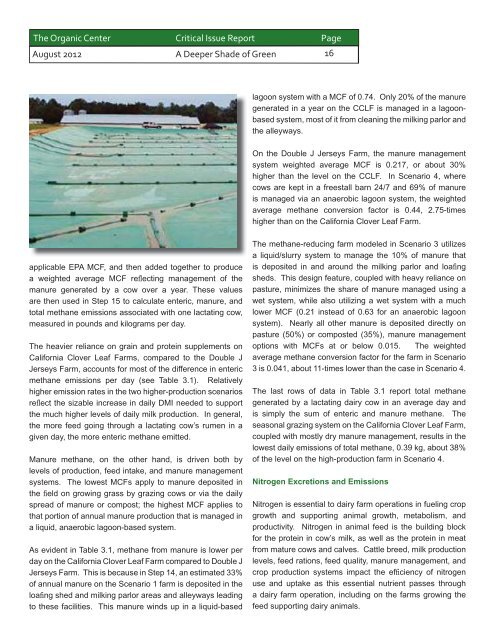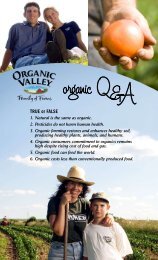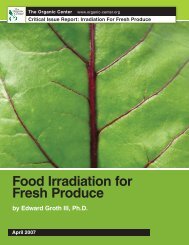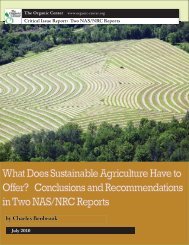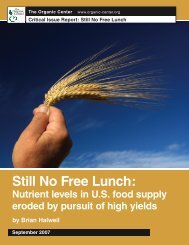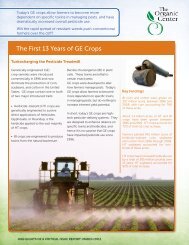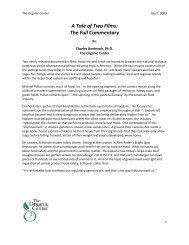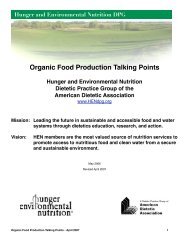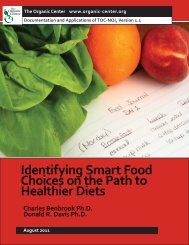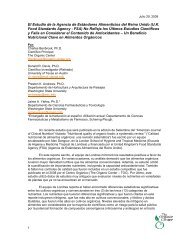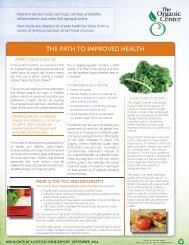Full Report - The Organic Center
Full Report - The Organic Center
Full Report - The Organic Center
You also want an ePaper? Increase the reach of your titles
YUMPU automatically turns print PDFs into web optimized ePapers that Google loves.
<strong>The</strong> <strong>Organic</strong> <strong>Center</strong> Critical Issue <strong>Report</strong> Page<br />
August 2012 A Deeper Shade of Green 16<br />
lagoon system with a MCF of 0.74. Only 20% of the manure<br />
generated in a year on the CCLF is managed in a lagoonbased<br />
system, most of it from cleaning the milking parlor and<br />
the alleyways.<br />
On the Double J Jerseys Farm, the manure management<br />
system weighted average MCF is 0.217, or about 30%<br />
higher than the level on the CCLF. In Scenario 4, where<br />
cows are kept in a freestall barn 24/7 and 69% of manure<br />
is managed via an anaerobic lagoon system, the weighted<br />
average methane conversion factor is 0.44, 2.75-times<br />
higher than on the California Clover Leaf Farm.<br />
applicable EPA MCF, and then added together to produce<br />
a weighted average MCF refl ecting management of the<br />
manure generated by a cow over a year. <strong>The</strong>se values<br />
are then used in Step 15 to calculate enteric, manure, and<br />
total methane emissions associated with one lactating cow,<br />
measured in pounds and kilograms per day.<br />
<strong>The</strong> heavier reliance on grain and protein supplements on<br />
California Clover Leaf Farms, compared to the Double J<br />
Jerseys Farm, accounts for most of the difference in enteric<br />
methane emissions per day (see Table 3.1). Relatively<br />
higher emission rates in the two higher-production scenarios<br />
refl ect the sizable increase in daily DMI needed to support<br />
the much higher levels of daily milk production. In general,<br />
the more feed going through a lactating cow’s rumen in a<br />
given day, the more enteric methane emitted.<br />
Manure methane, on the other hand, is driven both by<br />
levels of production, feed intake, and manure management<br />
systems. <strong>The</strong> lowest MCFs apply to manure deposited in<br />
the fi eld on growing grass by grazing cows or via the daily<br />
spread of manure or compost; the highest MCF applies to<br />
that portion of annual manure production that is managed in<br />
a liquid, anaerobic lagoon-based system.<br />
As evident in Table 3.1, methane from manure is lower per<br />
day on the California Clover Leaf Farm compared to Double J<br />
Jerseys Farm. This is because in Step 14, an estimated 33%<br />
of annual manure on the Scenario 1 farm is deposited in the<br />
loafi ng shed and milking parlor areas and alleyways leading<br />
to these facilities. This manure winds up in a liquid-based<br />
<strong>The</strong> methane-reducing farm modeled in Scenario 3 utilizes<br />
a liquid/slurry system to manage the 10% of manure that<br />
is deposited in and around the milking parlor and loafi ng<br />
sheds. This design feature, coupled with heavy reliance on<br />
pasture, minimizes the share of manure managed using a<br />
wet system, while also utilizing a wet system with a much<br />
lower MCF (0.21 instead of 0.63 for an anaerobic lagoon<br />
system). Nearly all other manure is deposited directly on<br />
pasture (50%) or composted (35%), manure management<br />
options with MCFs at or below 0.015. <strong>The</strong> weighted<br />
average methane conversion factor for the farm in Scenario<br />
3 is 0.041, about 11-times lower than the case in Scenario 4.<br />
<strong>The</strong> last rows of data in Table 3.1 report total methane<br />
generated by a lactating dairy cow in an average day and<br />
is simply the sum of enteric and manure methane. <strong>The</strong><br />
seasonal grazing system on the California Clover Leaf Farm,<br />
coupled with mostly dry manure management, results in the<br />
lowest daily emissions of total methane, 0.39 kg, about 38%<br />
of the level on the high-production farm in Scenario 4.<br />
Nitrogen Excretions and Emissions<br />
Nitrogen is essential to dairy farm operations in fueling crop<br />
growth and supporting animal growth, metabolism, and<br />
productivity. Nitrogen in animal feed is the building block<br />
for the protein in cow’s milk, as well as the protein in meat<br />
from mature cows and calves. Cattle breed, milk production<br />
levels, feed rations, feed quality, manure management, and<br />
crop production systems impact the effi ciency of nitrogen<br />
use and uptake as this essential nutrient passes through<br />
a dairy farm operation, including on the farms growing the<br />
feed supporting dairy animals.


